Note: This page is hosted on the Orange County Sustainability Decathlon (OCSD) Team Portal. If you are not currently on a OCSD team, most of the links in the top navigation will not work because they are available to registered OCSD team members only.
Get Started
- Review the page below and select which element(s) you’d like to create for the Showcase.
- Schedule a meeting with our co-directors (green button below).
- Turn in your completed application (white button below).
- Once your application is approved, congratulations! You’ll be in communication with our organizers throughout the summer in preparation for the Showcase in October 2023.
Email us at showcase@ocsd23.com.
Showcase Location
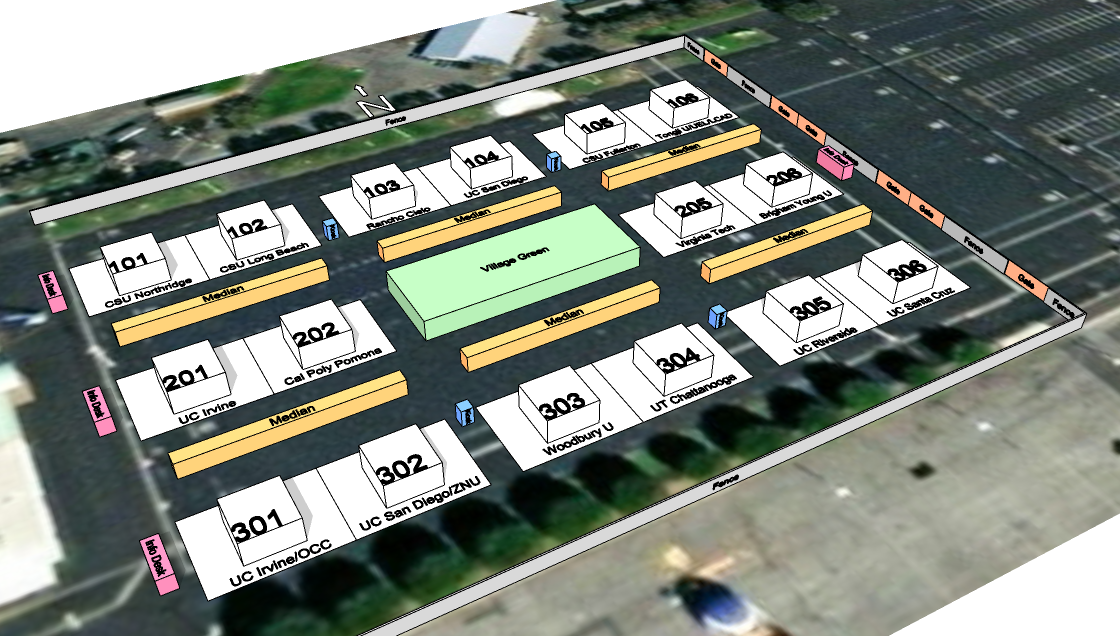
Element Briefs
The following video walkthrough highlights the locations and scale of the proposed village support structures that will be designed and built by STEAM Student Showcase participants.
Color Key for Showcase Elements:
- Green: Village Green
- Gold: Medians
- Blue: Kiosks
- Pink: Info Desks
- Salmon/Grey: Fence Gates and Fixed Fence Segments, respectively
Purpose
The Village Green will transform a bare asphalt plot in the middle of the OCSD Village into a lively and welcoming epicenter.
Required Features
- General public seating for resting, eating, reading, etc.
- Drought-resistant landscaping
- Green space(s) for lounging and playing
- Several versatile areas for small food and beverage vendors; display tables; and freestanding exhibits, games, and social media backdrops
- A focal point, such as a stage or arena, for presentations and performances
- Device charging stations
Quantity
We need one (1) Village Green.
Location
The Village Green will be located in the center of the OCSD Village and will be surrounded on all sides by OCSD model homes, as indicated in the village model below.
Size
All components comprising the Village Green must be located within a 160 ft (E-W) by 60 ft (N-S) footprint. The maximum height of Village Green components is 16 ft.
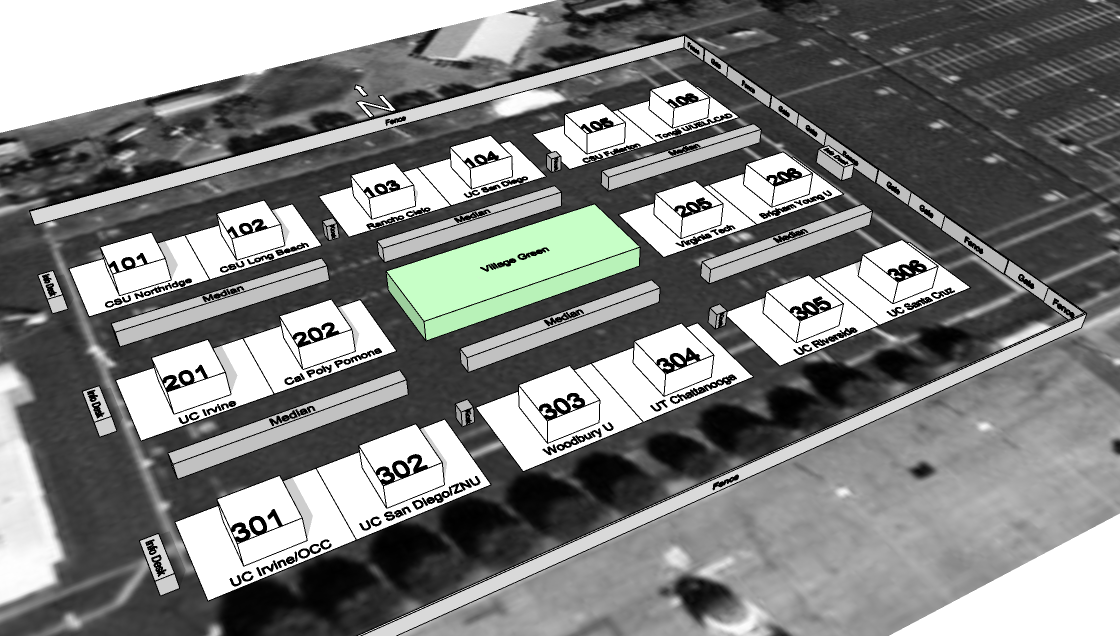
Purpose
The medians transform the village’s two broad central streets into charming promenades. In addition to enhancing village aesthetics, they provide places to sit, rest, and view the model homes.
Required Features
- Integrated public seating areas
- Planters containing drought-tolerant plants
- Ambient lighting for pedestrian safety across the entire 70-ft width of the pedestrian malls
Quantity
We need six (6) medians.
Locations
The medians will bisect the village’s two central streets in six locations, as indicated in the village model below.
Size
The collection of components comprising a median must be located within a 140 ft E-W by 10 ft N-S footprint. The streets on either side of a median are 30 ft wide.
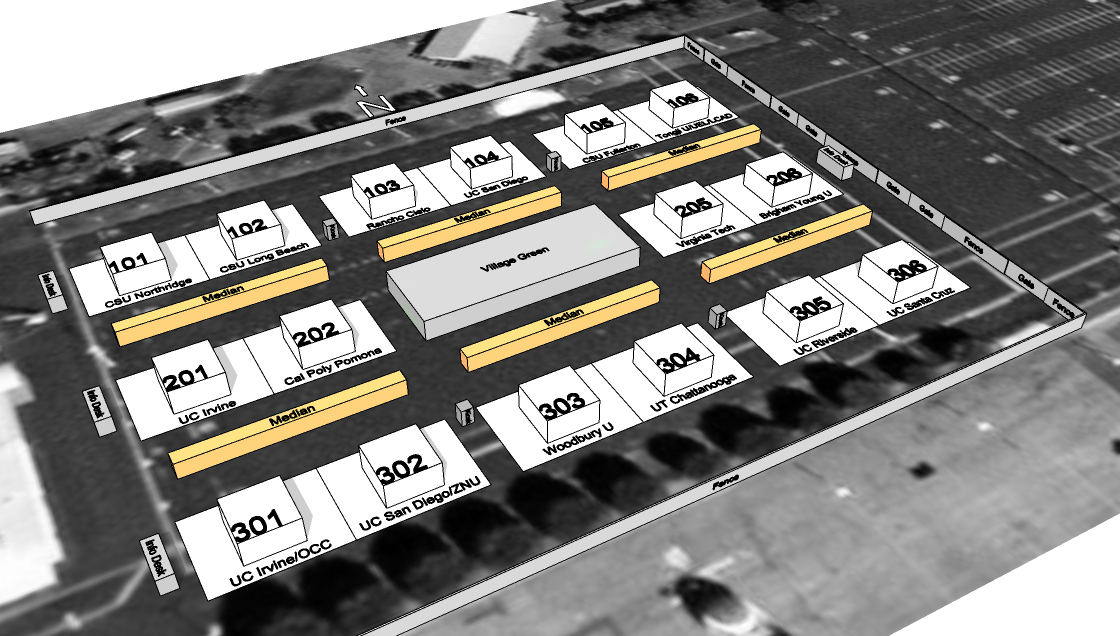
Purpose
While walking through the village, guests may stop at a kiosk to do the following:
- Fill up their water bottles
- Wash their hands
- Charge their devices
- Orient themselves on a map
- Check the schedule of events
- Take a brief rest
- Cool down
Required Features
- Hydration station(s) (water must be dispensed from organizer-supplied 5-gallon jugs)
- Hand-washing station(s) (water container may be filled periodically from a garden hose)
- Device charging station(s)
- Internet-connected touchscreen kiosk
- Integrated Wifi access point, extender, or mesh node
- Grid-independent energy generation and storage
- Nighttime lighting for safety and for reading printed materials
Optional Features
- Seating
- Active and/or passive cooling (e.g. shading devices, misters, fans, etc.)
- Educational, informational, and/or entertainment features
- Means of protecting devices from theft and environmental exposure while charging
- Other features proposed by the applicant
Quantity
We need as few as four (4) and as many as six (6) kiosks.
Locations
Up to four kiosks will be located on the north and south segments of the two cross streets, as indicated in the village model below. Up to two more kiosks will be located elsewhere on the competition site outside the village perimeter.
Size
The maximum length, width, or diameter of a kiosk is 8 ft. The maximum height of a kiosk is 12 ft.
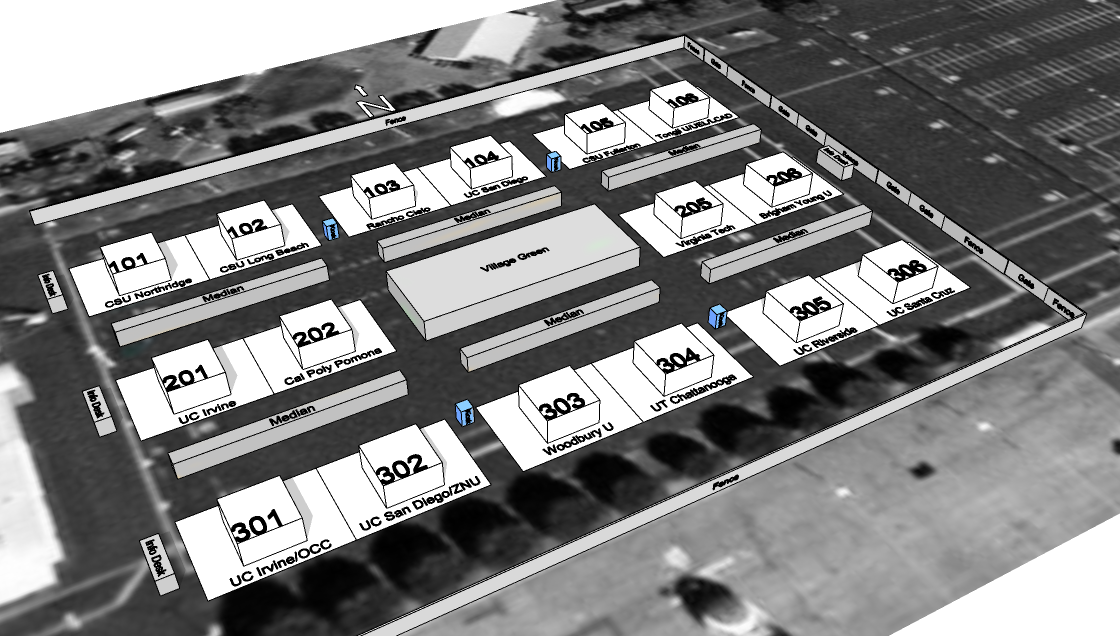
Purpose
While approaching the village, guests may stop at an info desk to do the following:
- Orient themselves on a map
- Take or read materials about the houses in the info desk’s row
- Take a printed OCSD program or scan a QR code to access the digital version of the program
- Ask questions of the person(s) staffing the info desk
- Check the schedule of events
- Buy a water bottle or t-shirt; take a sticker
- Start a self-guided tour or join a scheduled guided tour of the houses in the info desk’s row
Required Features
- Means to display the competition site map and detailed row map (printed or digital)
- Internet-connected screen for displaying dynamic information, such as the schedule of events, competition results, alerts/news, etc.
- Comfortable seating location for the person(s) staffing the info desk
- Nighttime lighting for safety and for reading printed materials
- Place to display samples of objects being sold and given away
- Storage location for daily inventory of objects being sold or given away
- Price display for objects being sold
Optional Features
- Chair/seat for person(s) staffing the info desk
- Other features proposed by the applicant
Quantity
We need four (4) info desks.
Locations
Three info desks will be located at the west end of the village—one at the end of each row of houses, i.e., the “100 row,” “200 row,” and “300 row.” The fourth info desk will be located at the east end of the “200 row.”
Size
Each info desk must not exceed 30 ft length (N-S), 10 ft width (E-W), or 12 ft height.
Other Considerations
Because there will be only one info desk on the east end of the village, that info desk must have the means to display the competition site map and the detailed row map (printed or digital) for each of the three rows of houses.
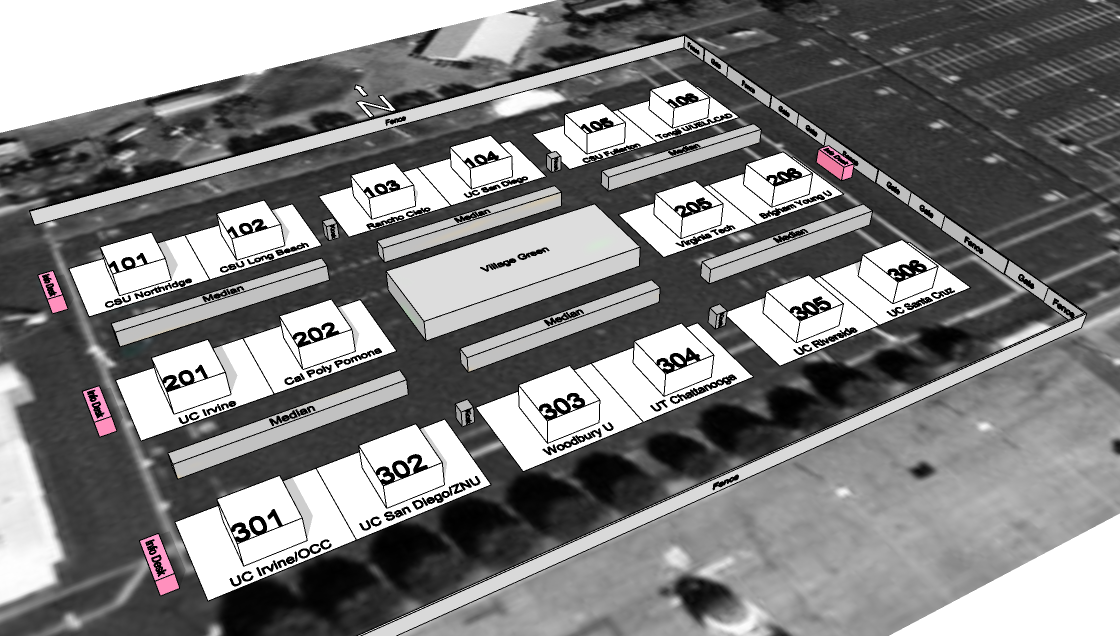
Purpose
From Instagram selfies to snapping memorable moments at the Orange County Sustainability Decathlon, these freestanding backdrops provide the ideal space to encourage attendees to take a perfect photo.
Optional Features
- Furniture pieces
- Live plants/living walls
- Custom lighting components
- Artwork
Quantity
We need as few as four (4) and as many as six (6) separate backdrops.
Locations
These elements will be installed in different locations on the competition site, including in the Village Green and near the competition site’s main entrance.
Size
We are not explicitly specifying minimum or maximum dimensions. Choosing appropriate dimensions is a design decision.
Other Requirements and Considerations
- All backdrops must include both the OCSD Primary Logo and signage to encourage the use of hashtag #OCSD23
- Backdrop designs may target specific age demographics, such as Grades K-8, Ages 14-16, Ages 21-25, etc.
Purpose
Your panels will not only beautify our otherwise ugly chain link village perimeter fence but also showcase sustainability-themed artwork and artwork that promotes the protection of Orange County’s natural habitats.
Material Requirements
Try to maximize the use of recycled art supplies, sustainable materials, or recycled items.
Location
The panels will be mounted on the village and competition site’s perimeter fences. The best panels will be mounted in the most visible locations, such as the fence gates at the east end of the village.
Panel Specifications and Logistics
- The required panel substrate is a 4 ft-by-8 ft exterior-grade plywood sheet that will be mounted in landscape orientation.
- 3D items may be screwed (preferred) or otherwise attached to the plywood substrate.
- Half-inch thick plywood should be used unless three-quarter-inch plywood is required to accommodate longer screws for mounting heavier items.
- If you want to partially or completely decorate and/or assemble your panel(s) before arriving on the competition site, you must purchase the plywood sheet(s) yourself and transport the panel to the competition site.
- If you want to avoid purchasing the plywood sheet(s) and transporting the panel(s) to the competition site, you may decorate and/or assemble your panel(s) on the competition site using plywood sheet(s) supplied by the OCSD Organization.
- Panels requiring more than one plywood sheet are permitted. Multi-sheet panels are actually encouraged because we have a lot of fencing to cover! On your application, please how many plywood sheet(s) and what sheet thickness you need.
- Leave a 12 in. wide by 8 in. tall blank area in the upper-right corner of your panel. If you have a multi-sheet panel, this blank area is only required on the rightmost sheet. The Showcase administrators will use this space to label each panel with identifying information and other information that may be interesting to visitors.
- Mounting hardware will be installed near each of the four (4) corners of each plywood sheet. To accommodate this hardware, avoid locating any critical design features within a 5 in. radius of each corner. Additional mounting hardware may be installed at other locations around the sheet perimeter if circumstances warrant. Therefore, to be extra careful, avoid locating any critical design features within 5 in. of sheet edges.
Purpose
We will use the trophies to recognize the top finishers in the OCSD competition and its associated ten contests.
Required Features
- Made from sustainable/recycled materials
- Creative design that does not closely resemble common commercial trophy designs.
- Durable and freestanding
- Incorporate the OCSD primary logo and the California Natural Resources Agency logo
Types and Quantities
We need the following four unique types of trophies (quantities of each type are indicated):
- (More than) Thirty (30) Contest Trophies: Ten individually-scored contests comprise the competition; the first, second, and third place finishers in each contest get a trophy. However, because some ties are likely, we don’t know exactly how many first, second, and third place finishers there will be for each contest. To avoid building a large number of extra trophies to accommodate all possible tie scenarios in all contests, please plan to build about forty identical “blank” contest trophies that do not indicate the contest name or the place of finish. Thirty of the blank contest trophies will be displayed on the main stage; the extra ten will serve as backups in case of ties that require us to distribute more than three trophies for particular contests. Design the trophies so that the contest name and place of finish can be applied after the contest results are known. The simplest way to accomplish this is to create plates that are printed/engraved and then affixed to the trophy body. We encourage you to come up with a creative solution to this problem. Depending on the logistics involved in completing and distributing each contest trophy, we understand that teams may not be able to take their contest trophy(s) home with them when they leave the competition site. It may be necessary to mail them the entire trophy or just the “plates” (or equivalent) at a later date. This is not ideal but is acceptable.
- One (1) First Place Competition Trophy: This must be the largest of all trophies. It goes to the team with the highest composite score across all ten contests.
- One (1) Second Place Competition Trophy: This must be the second largest of all trophies. It goes to the team with the second highest composite score across all ten contests.
- One (1) Third Place Competition Trophy: The must be the third largest of all trophies. It goes to the team with the third highest composite score across all ten contests.
Unlike contest scores, it is highly improbable that composite competition scores will result in ties. Therefore, it is only necessary to build three Competition Trophies. Each of the Competition Trophies should have the place of finish integrated into them during the build such that the Competition Trophies are complete when they are distributed at the end of the competition.
Location
The trophies will be displayed on the OCSD main stage throughout the competition period until they are distributed to the recipients at the conclusion of the competition.
Size
- Contest trophies should be no less than 12 in. tall and 5 in. wide
- Competition trophies should be 16 to 24 in. tall
Purpose
“Other Elements” is a catchall category for Showcase elements that do not belong to any of the element categories described above. This includes but is not limited to games, art, apps, exhibits, demonstrations, performances, and presentations. The possibilities are limited only by your imagination and creativity!
Locations
We will work with you to determine an appropriate location for your Showcase element. If your Showcase element is something intangible, such as a presentation or performance, we will probably locate you in either the Village Green and/or one of the permanent OC Fair & Event facilities, both of which will be outfitted with lighting and A/V equipment.
Important Dates
| wdt_ID | Date (or Date Range) | Event | Notes |
|---|---|---|---|
| 4 | Spring 2023 | Design and Application Phase | Prospective Showcase participants are designing their Showcase element(s) and submitting their designs for consideration by the Orange County Sustainability Decathlon organizers. |
| 5 | Summer 2023 | Build and Test Phase | Showcase participants are building and testing. Showcase administrators are monitoring the participants' progress. |
| 6 | Sep 25–Oct 3, 2023 | Set-Up | OCSD competition site and village are open for STEAM Student Showcase set-up, commissioning, and safety inspections |
| 7 | Oct 5–8 and 12–15, 2023 | Open to Public | OCSD competition site, village, houses, and STEAM Student Showcase are open to the public from 3 p.m. to 9 p.m. on Thursdays and Fridays and from 10 a.m. to 4 p.m. on Saturdays and Sundays. |
| 8 | Oct 16–20, 2023 | Teardown | OCSD competition site and village are open for STEAM Student Showcase teardown. |
General Requirements and Considerations
All design requirements and considerations listed below apply to kiosks, info desks, medians, village green, social media backdrops, and free-standing exhibits. Many of these requirements and considerations do not apply to fence panels, competition trophies, and element that fall under the “Other Elements” category. If it is not obvious whether a particular requirement or consideration applies to your specific Showcase element, please request a clarification by using the “Ask a Question” button below.
Sustainability and Purpose
- Each Showcase element must incorporate sustainable materials, demonstrate sustainable design principles, and/or teach sustainability concepts.
- Each Showcase element must educate, inform, entertain, inspire, or provide comfort to village guests. The best elements will provide several of these functions.
Safety and Compliance
- Provide an accessible route through the Showcase element.
- The OCSD Building Official will review the design documentation and conduct on-site inspections of all elements that may pose a safety risk to village guests if the elements were designed or installed improperly.
- If the OCSD Building Official is unable to determine the structural safety of the element based on a cursory review of the design documentation, he may require that the design be approved (stamped) by a licensed engineer. It is your responsibility to obtain this engineering approval, so consider involving a licensed engineer in your design process if you suspect that the OCSD Building Official may require engineering approval.
- Because the Showcase elements are part of a temporary exhibition, they are not subject to seismic design requirements.
- The village is located on an asphalt parking lot. To avoid damaging the surface, keep your structure below the 3000 psf maximum bearing pressure.
Environmental Design Conditions
- Showcase elements will be exposed to weather (sun, wind, rain), so design and plan accordingly. It is the participants’ responsibility to weatherproof their elements and/or deploy means of weather protection, as necessary.
- The design wind speed is a 3-second gust @ 60 mph. Village guests will be evacuated if winds approach this design wind speed.
- The village will be open in October in Costa Mesa, when the average daily low temperature is approximately 59°F and the average daily high temperature is approximately 77°F. During the past three Octobers, the highest recorded temperature was 96°F and the lowest recorded temperature was 53°F.
- The village will be open from 3 p.m. to 9 p.m. PDT. Sunset is at approximately 6:30 p.m. PDT. A relatively low level of ambient site lighting will be provided for pedestrian safety, but participants must provide lighting for their Showcase elements.
Utilities
- 120/240VAC electrical power will be available to participants, but grid-independent Showcase elements are encouraged.
- An Internet connection (type and bandwidth TBD) will be available to Showcase elements that require one.
- For Showcase elements that require water to operate, “tap” water is available from hose bibbs/spigots around the site, but Showcase participants are not permitted to run pipes or hoses to their elements.
- Showcase elements that include a drinking water “hydration station” feature must accommodate typical 5-gallon water jugs that are common in office water dispensers. The water jugs will be supplied by OCSD organizers.
